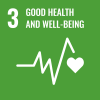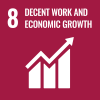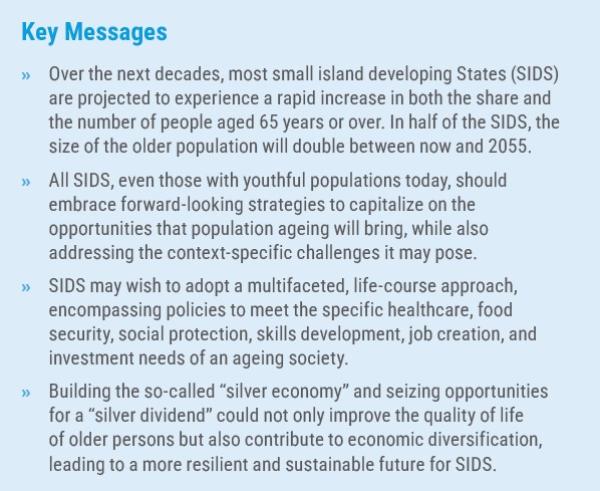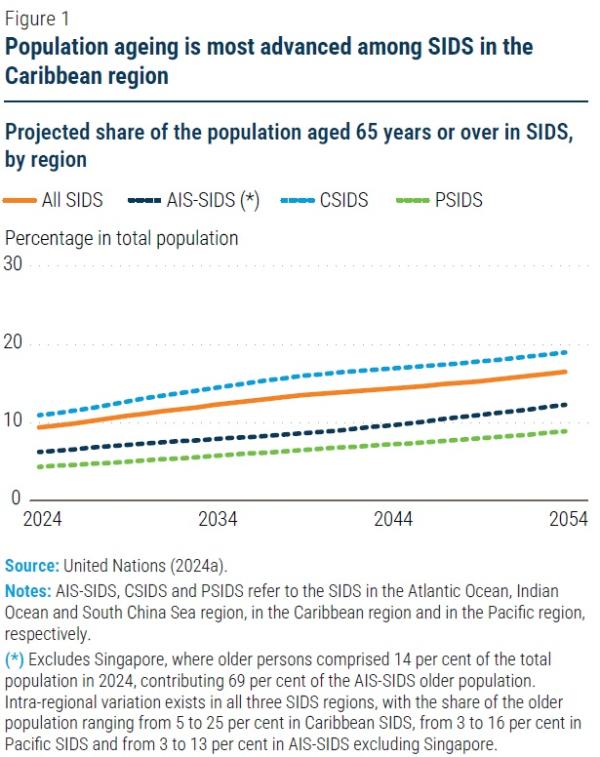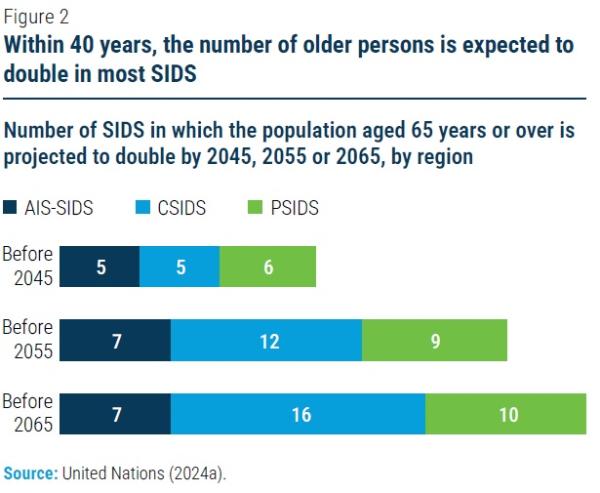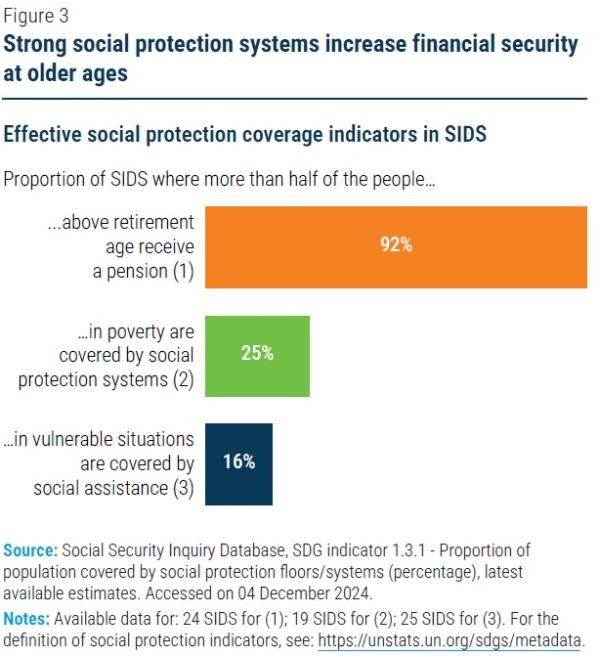
SIDS FACE UNIQUE SOCIAL, ECONOMIC AND ENVIRONMENTAL VULNERABILITIES
SIDS are a heterogeneous group of islands and coastal states with significant differences in population size and density, geographical dispersion, natural resources and development progress (United Nations, 2023a). Yet, SIDS face both common and specific challenges arising from their geographical conditions, such as heightened expo-sure to natural hazards and increased susceptibility to climate change and sea-level rise, among other intersecting features. Their small population size, narrow resource base and limited land area preclude economies of scale and diversification, making them more vulnerable to external shocks and stressors. Many small island economies are heavily dependent on remittances from overseas workers. Moreover, the share of informal employment and other pre-carious forms of work is high in many SIDS, contributing to gaps in social protection systems and exacerbating social exclusion. In addition, the rising prevalence of noncommunicable diseases (NCDs) and associated risk factors is straining healthcare systems in many SIDS.
The fourth programme of action on sustainable development for SIDS, the Antigua and Barbuda Agenda for SIDS (ABAS) identifies these characteristics among the many factors likely to present distinct social and economic challenges for SIDS as they shift towards ageing societies. Anticipating the extent and pace of population ageing can help turn these challenges into opportunities by building a more resilient and sustainable future for these States.
MOST SIDS WILL EXPERIENCE RAPID POPULATION AGEING OVER THE NEXT FEW DECADES
Today, people aged 65 years or over represent almost 10 per cent of the total SIDS population; a share that is twice as high as in other groups of countries in special situations (United Nations, 2023a, 2024a; Box 1). Population ageing in SIDS is more advanced in the Caribbean region (CSIDS) than in the Pacific region (PSIDS) or in the Atlantic Ocean, Indian Ocean and South China Sea region (AIS-SIDS). For example, in 2024, the share of older persons stood at 10 per cent or more in about two thirds of CSIDS, compared to nearly one third of PSIDS and one fourth of AIS-SIDS. On average, the share of older people in SIDS is projected to continue increasing and to reach 17 per cent of the total population by 2055 (Figure 1).
The number of persons aged 65 years or over in all SIDS, which stood at 6.9 million in 2024, is projected to reach 10 million in the mid-2030s and could climb to 15 million by the late 2050s (United Nations, 2023a, 2024a). In 28 SIDS, the size of the older population is expected to double between now and 2055 (Figure 2). This group includes several States where population ageing is already more advanced, such as Antigua and Barbuda, Jamaica and Suriname in the Carib-bean, some of the French territories in the Pacific and Singapore in the AIS region. The older population is also projected to grow rapidly in States where its current share of the total remains small. These include Belize, Guyana and Haiti in the Caribbean; Kiribati, Papua New Guinea and Timor-Leste in the Pacific; and Comoros, Guinea-Bissau and Sao Tome and Principe in the AIS region.
In four of the five most populous SIDS—Dominican Republic, Haiti, Papua New Guinea and Singapore—the older population is projected to double in size sometime between the late 2030s and the late 2040s. Combined, these four States are home to more than half of the older population currently residing in SIDS.
POPULATION AGEING POSES DISTINCT CHALLENGES AND OPPORTUNITIES IN SIDS
The rapid increase in the share and number of older persons poses context-specific challenges for SIDS. For example, in SIDS where formal employment is low and where financial support at older ages is provided primarily by family members, rapid ageing of the population could put large numbers of people, particularly older women, at heightened risk of economic insecurity (United Nations, 2023b). Several SIDS, including Comoros, Timor-Leste, and Tonga, have high shares of informal employment, or face pressing shortages of doctors, nurses, and other health workers.
Food systems, unhealthy diets, and the growing burden of NCDs pose a major challenge for many SIDS. Due to geo-graphical and socioeconomic factors, including remoteness, small population size and limited availability of land, agriculture in SIDS is often uncompetitive, making SIDS highly dependent on imported foods, which are often ultra-processed and thus high in sugar, salt and fat. In many SIDS, unhealthy diets associated with rising consumption of ultra-processed foods have been the leading cause of a rapid increase in obesity, particularly among women (FAO, UN-OHRLLS and UNDESA, 2017; WHO, 2023a). Thirteen of the top 15 countries with the highest adult obesity prevalence worldwide are Pacific SIDS. Nine SIDS, mostly in the Pacific region, are among 20 countries with the highest mortality rates attributed to NCDs, including cardiovascular disease, cancer, diabetes or chronic respiratory disease. As SIDS populations continue to age, the burden of these chronic dis-eases is likely to rise further unless concrete steps are taken.
Population ageing also presents distinct opportunities. SIDS economies, for instance, could expand markets for products and services aimed at the older population, known as the “silver economy” (Sánchez and others, 2020). Strengthening healthcare and home care systems, and investing in infra-structure, transport and other service-driven subsectors targeting the needs of older persons, including returning migrants, could offer economic growth and diversification opportunities and contribute to greater economic resilience.
In addition, training and education programmes for older persons on healthy ageing and disaster preparedness and response could generate new jobs in those sectors. Moreover, because persons aged 65 or over in SIDS increasingly participate in the labour force, creating decent and productive employment opportunities for older workers can also generate valuable human capital resources, particularly in States where population size is projected to decline (United Nations, 2024b). This “silver dividend” (ADB, 2024; Park and Shin, 2023) can promote intergenerational solidarity, increase autonomy and well-being at older ages, and expand SIDS’ productive capacities in traditional and new sectors of the economy.
POLICIES TO PROMOTE INCLUSIVE SOCIETIES FOR ALL AGES
Creating socially inclusive communities for all ages in line with the Madrid International Plan of Action on Ageing 2002 (MIPAA) requires a forward-looking, multifaceted, life-course approach, encompassing policies to expand access to healthcare and social protection and promote skills development and job creation. For SIDS facing the rapid ageing of their populations, selected strategies to promote supportive environments and lay the ground for a silver dividend are presented below. These approaches must be tailored to address differences among SIDS in their demographic situations and in their social, economic and environmental contexts.
First, SIDS should consider strengthening and building more equitable and resilient social protection systems to increase financial security at older ages. As population ageing accelerates in SIDS, greater efforts are needed to strengthen contributory and non-contributory pension systems to ensure economic security among older persons and their families (Figure 3). Combining such systems with mechanisms to create decent jobs, particularly in economies with a high degree of informality, and to allow flexible retirement schemes for older persons who desire to continue to work and can do so, will help ensure more adequate social protection at older ages, especially for women, with potential beneficial spillovers to family members and communities at large.
In addition, rapid population ageing in SIDS requires implementing or strengthening social protection mechanisms aimed at providing food, healthcare and other services to older persons affected by disasters caused by natural hazards, health emergencies and other external shocks. Experiences from the Dominican Republic, Fiji, Jamaica and the ASEAN region in implementing adaptive social protection and shock-responsive social protection (ASP and SRSP), as well as anticipatory social safety net mechanisms, can help chart a course towards more resilient systems in other SIDS.
Second, SIDS should seek to support local food production, increase food security, and promote healthy diets at all ages to reduce the rising incidence of NCDs and promote healthy ageing. Supporting and investing in sustainable local agriculture, fisheries, and aquaculture and forestry can help reduce SIDS’ dependency on imported foods while advancing overall food security and nutrition, resulting in more sustainable and climate-resilient societies with ageing populations (WHO, 2023a, 2023b).
Gender-sensitive campaigns to promote physical activity and healthy diets from childhood and throughout the life course can also help reduce the growing incidence of NCDs. As SIDS populations continue to age, it will be critical to strengthen health systems, including building and retaining a skilled health workforce, focusing on primary healthcare, universal health coverage and long-term care (United Nations, 2023b; WHO, 2021). Expanded use of digital health applications and real-time remote medicine can contribute to the prevention and early diagnosis of NCDs, reducing expenditures for long-term healthcare services and helping to reach the furthest behind first (Pacific Communities and WHO, 2023). Putting in place or enhancing data systems to monitor the specific needs of older persons will help lower healthcare costs and address their vulnerabilities.
Third, SIDS should expand opportunities for life-long learning and digital literacy, facilitating the employment of older persons who wish to continue working. As SIDS undergo a digital transformation, building digital literacy skills among older persons, including through inclusive adult learning and education strategies, will increase connectivity and contribute to bridging digital divides and growing a “digital culture” that spans generations. Universities of the Third Age and other lifelong learning initiatives offer online training opportunities for older persons, including reskilling and upskilling programmes with a focus on “green and decent” jobs (ILO, 2017).
Incentives for employers to hire and retain older workers, including through flexible working arrangements, can help encourage older persons to stay in the workforce. Improving access to digital tools for the financial inclusion of older persons can promote entrepreneurship and facilitate paths into sectors with high digital potential, such as tourism and climate-smart industries (ADB, 2024; UNDP, 2024).
Lastly, SIDS must empower the older population through participation and engagement in climate justice and disaster prevention and management. The increasing frequency and intensity of natural hazards pose a growing threat to the well-being of SIDS’ populations. Older persons, including retirees, community leaders and women, have the potential to become advocates for action on climate change. Civic participation and meaningful engagement can open new pathways for older persons to express their concern for and commitment to the well-being of future generations (Pillemer and others, 2022), mobilize other members of their communities, and promote intergenerational solidarity.
By advocating for age- and gender-responsive, people-centered early warning systems, older adults can support disaster risk reduction efforts in SIDS and mobilize their community knowledge to increase the effectiveness of such systems. Through skills development and awareness campaigns focused on the impact of climate change at the local level, older persons can become stewards for climate action.
 Welcome to the United Nations
Welcome to the United Nations
